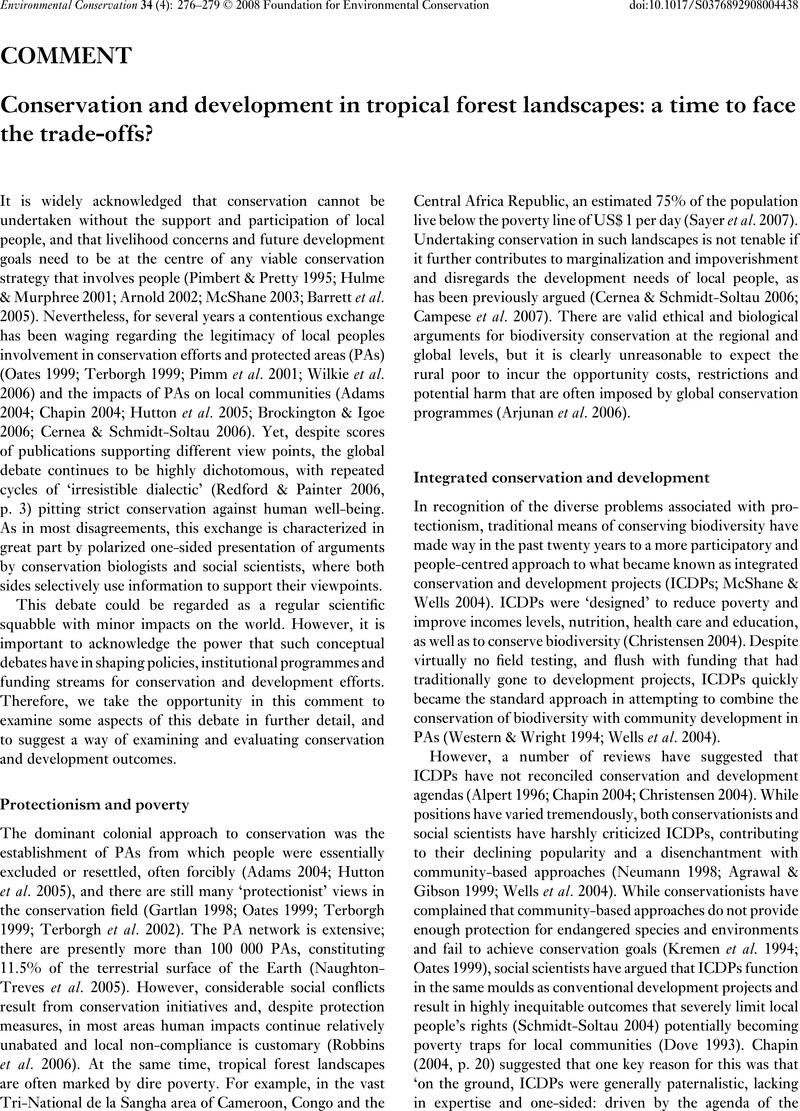Crossref Citations
This article has been cited by the following publications. This list is generated based on data provided by Crossref.
Holland, Margaret Buck
2012.
Integrating Ecology and Poverty Reduction.
p.
253.
Rantala, SallaE
Vihemäki, Heini
Swallow, BrentM
and
Jambiya, George
2013.
Who Gains and Who Loses from Compensated Displacement from Protected Areas? The Case of the Derema Corridor, Tanzania.
Conservation and Society,
Vol. 11,
Issue. 2,
p.
97.
Dressler, WolframH
To, PhucXuan
and
Mahanty, Sango
2013.
How Biodiversity Conservation Policy Accelerates Agrarian Differentiation: The Account of an Upland Village in Vietnam.
Conservation and Society,
Vol. 11,
Issue. 2,
p.
130.
Kelman, CandiceCarr
2013.
Governance Lessons from Two Sumatran Integrated Conservation and Development Projects.
Conservation and Society,
Vol. 11,
Issue. 3,
p.
247.
Muradian, Roldan
2013.
Payments for Ecosystem Services as Incentives for Collective Action.
Society & Natural Resources,
Vol. 26,
Issue. 10,
p.
1155.
Sayer, Jeffrey
Sunderland, Terry
Ghazoul, Jaboury
Pfund, Jean-Laurent
Sheil, Douglas
Meijaard, Erik
Venter, Michelle
Boedhihartono, Agni Klintuni
Day, Michael
Garcia, Claude
van Oosten, Cora
and
Buck, Louise E.
2013.
Ten principles for a landscape approach to reconciling agriculture, conservation, and other competing land uses.
Proceedings of the National Academy of Sciences,
Vol. 110,
Issue. 21,
p.
8349.
Peterson, NicoleD
2014.
Breaking the Bounds of Rationality: Values, Relationships, and Decision-making in Mexican Fishing Communities.
Conservation and Society,
Vol. 12,
Issue. 3,
p.
245.
Sunderland, Terry
Baudron, Frédéric
Ickowitz, Amy
Padoch, Christine
Ros-Tonen, Mirjam
Sandbrook, Chris
Vira, Bhaskar
Chambers, Josephine
Deakin, Elizabeth
Foli, Samson
Jeary, Katy
Parrotta, John A.
Powell, Bronwen
Reed, James
Ayeri Ogalleh, Sarah
Neufeldt, Henry
and
Serban, Anca
2015.
Forests and Food.
p.
181.
Sayer, Jeffrey
Margules, Chris
Boedhihartono, Agni Klintuni
Dale, Allan
Sunderland, Terry
Supriatna, Jatna
and
Saryanthi, Ria
2015.
Landscape approaches; what are the pre-conditions for success?.
Sustainability Science,
Vol. 10,
Issue. 2,
p.
345.
Asner, Gregory P.
Martin, Roberta E.
Tupayachi, Raul
and
Llactayo, William
2017.
Conservation assessment of the Peruvian Andes and Amazon based on mapped forest functional diversity.
Biological Conservation,
Vol. 210,
Issue. ,
p.
80.
Pechanec, Vilem
Machar, Ivo
Sterbova, Lenka
Prokopova, Marcela
Kilianova, Helena
Chobot, Karel
and
Cudlin, Pavel
2017.
Monetary Valuation of Natural Forest Habitats in Protected Areas.
Forests,
Vol. 8,
Issue. 11,
p.
427.
Reibelt, Lena M.
and
Waeber, Patrick O.
2018.
Primates.
O’Connor Robinson, Megan
Selfa, Theresa
and
Hirsch, Paul
2018.
Navigating the Complex Trade-Offs of Pesticide Use on Santa Cruz Island, Galapagos.
Society & Natural Resources,
Vol. 31,
Issue. 2,
p.
232.
Suwarno, Aritta
van Noordwijk, Meine
Weikard, Hans-Peter
and
Suyamto, Desi
2018.
Indonesia’s forest conversion moratorium assessed with an agent-based model of Land-Use Change and Ecosystem Services (LUCES).
Mitigation and Adaptation Strategies for Global Change,
Vol. 23,
Issue. 2,
p.
211.
Hofner, Alexandra N.
Jost Robinson, Carolyn A.
and
Nekaris, K. A. I.
2018.
Preserving Preuss’s Red Colobus (Piliocolobus preussi): an Ethnographic Analysis of Hunting, Conservation, and Changing Perceptions of Primates in Ikenge-Bakoko, Cameroon.
International Journal of Primatology,
Vol. 39,
Issue. 5,
p.
895.
Willig, Michael R
Presley, Steven J
Plante, Jean-Luc
Bloch, Christopher P
Solari, Sergio
Pacheco, Victor
and
Weaver, Scott C
2019.
Guild-level responses of bats to habitat conversion in a lowland Amazonian rainforest: species composition and biodiversity.
Journal of Mammalogy,
Vol. 100,
Issue. 1,
p.
223.
Rahman, Syed Ajijur
Baral, Himlal
Sharma, Roshan
Samsudin, Yusuf B.
Meyer, Maximilian
Lo, Michaela
Artati, Yustina
Simamora, Trifosa Iin
Andini, Sarah
Leksono, Budi
Roshetko, James M.
Lee, Soo Min
and
Sunderland, Terry
2019.
Integrating bioenergy and food production on degraded landscapes in Indonesia for improved socioeconomic and environmental outcomes.
Food and Energy Security,
Vol. 8,
Issue. 3,
Langston, James Douglas
Riggs, Rebecca Anne
Kastanya, Agustinus
Sayer, Jeffrey
Margules, Chris
and
Boedhihartono, Agni Klintuni
2019.
Science Embedded in Local Forest Landscape Management Improves Benefit Flows to Society.
Frontiers in Forests and Global Change,
Vol. 2,
Issue. ,
2019.
Withdrawn as duplicate: Guild-level responses of bats to habitat conversion in a lowland Amazonian rainforest: species composition and biodiversity.
Journal of Mammalogy,
Vol. 100,
Issue. 4,
p.
e1.
Watts, John D.
2020.
Community living standards and rural household decision making.
Journal of Rural Studies,
Vol. 80,
Issue. ,
p.
23.



